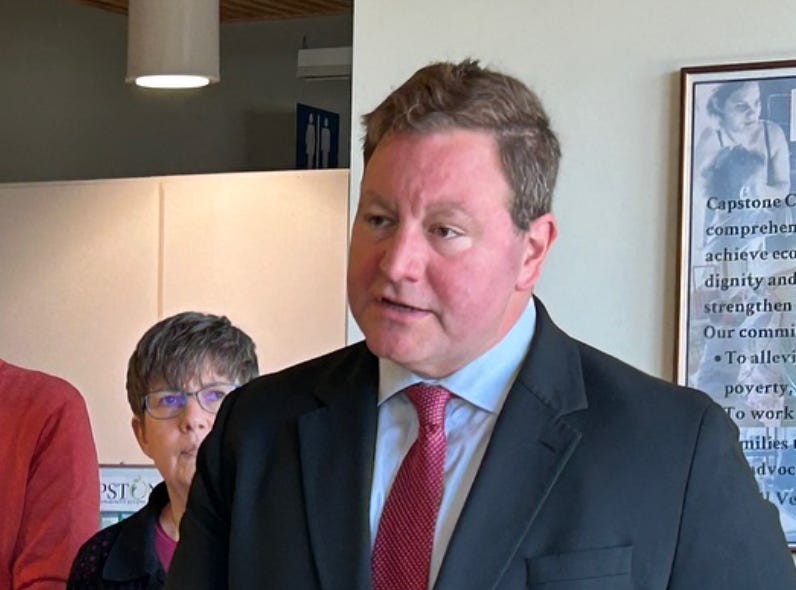Vermont Treasurer Targets Trump Meme Stock—But Here's Why Your Pension Is Safe
Trump Media makes up a minuscule 0.02% of the Russell 3000 total index—If its stock value went to zero tomorrow, the pension fund would lose less than two-hundredths of one percent.
Recently, Vermont State Treasurer Mike Pieciak made headlines by leading a group of state financial officers to challenge the inclusion of Trump Media & Technology Group (TMTG) in a major stock market index. The move was presented as a necessary step to protect the pensions of teachers, state employees, and other retirees from a uniquely risky company.
But is this a straightforward case of a watchdog protecting Vermonters’ savings, or is it a political battle being fought on the terrain of finance?
The answer is complicated. To fully understand the issue, we need to look beyond the headlines at the company in question, the rules of the stock market, and the real risks involved.
## The Heart of the Complaint: A Genuinely Risky Stock
On one point, Treasurer Pieciak’s assessment is undeniably correct: Trump Media (stock symbol: DJT) is an exceptionally unusual and financially unstable company.
According to its own public financial filings, the company, which runs the Truth Social platform, has negligible revenue—bringing in only around $3.7 million over the past year while losing hundreds of millions of dollars. Despite this, investors have valued the company in the billions. This massive disconnect between its real-world performance and its stock market valuation is the core of the problem.
This behavior has earned TMTG the label of a “meme stock,” a term for companies whose stock prices are driven by social media hype, political loyalty, and small-time traders rather than by traditional business success. Its value is wildly volatile, swinging dramatically based on news cycles related to Donald Trump. According to market data, the stock is over 4.5 times more volatile than the overall market.
So, when the Treasurer calls the company “phony, inflated, and dangerous,” he’s pointing to real financial data that would make any traditional investor extremely wary.
## The Index’s Side of the Story: It’s Just Math
This is the critical piece of the puzzle often left out of the initial news reports. The treasurers sent their letter to a company called FTSE Russell, which manages the Russell 3000 Index. So, what is this index, and why did it include TMTG?
Think of the Russell 3000 as a census of the U.S. stock market. Its only job is to provide a comprehensive, unbiased snapshot of the 3,000 largest publicly traded companies in the country. To do this, it follows a simple, publicly available, rules-based methodology. According to FTSE Russell’s own rules, a company gets included if it meets a few objective criteria:
It’s listed on a major exchange (like Nasdaq, where TMTG trades).
Its total value, or market capitalization, is above a certain minimum (TMTG’s is in the billions, far exceeding the threshold).
Its stock price is above $1.00.
At least 5% of its shares are available for public trading.
Crucially, the rulebook deliberately excludes any subjective judgment about a company’s quality. There are no rules about profitability, revenue, stability, or good governance. The index doesn’t endorse the companies in it; it simply reflects that, based on their market value, they are part of the U.S. stock market.
This isn’t a special case for TMTG. Other famous meme stocks, like GameStop (GME) and AMC Entertainment (AMC), were also added to the Russell indexes when their market values skyrocketed, despite their own underlying business struggles. To exclude TMTG would have required FTSE Russell to break its own rules.
## What’s the Real Risk to Vermonters’ Pensions?
Treasurer Pieciak’s letter states that TMTG’s inclusion places retirees at “unnecessary risk.” While this sounds alarming, the mathematics of diversification tell a different story.
State pension funds that use passive investing strategies don’t just buy a few stocks; they buy all 3,000 stocks in the Russell 3000 to mirror the market. TMTG, despite its high valuation, is just one of those 3,000 companies.
Because of its relatively small size compared to giants like Apple or Microsoft, TMTG makes up a minuscule fraction of the total index—likely less than 0.02%.
What does this mean in practical terms? It means that even if TMTG’s stock value went to zero tomorrow, a pension fund tracking the Russell 3000 would lose less than two-hundredths of one percent. This tiny dip would be completely lost in the normal daily fluctuations of the market. The principle of not putting all your eggs in one basket means the failure of a single small company has a virtually unnoticeable impact on a large, diversified portfolio. The real risk to pensions comes from broad market downturns, not the failure of a single meme stock.
## Politics, Pensions, and a Broader Pattern
If the direct financial risk is so small, why is this happening? This is where the broader political context becomes impossible to ignore.
According to public records and press releases, this action is consistent with a wider pattern of political and legal opposition by Vermont officials against the Trump administration. Treasurer Pieciak himself convened a task force in early 2025 specifically to assess and counter the economic impacts of the second Trump administration. At the same time, Vermont’s Attorney General, Charity Clark, has been involved in over two dozen lawsuits against the administration on issues from environmental policy to immigration.
When viewed through this lens, the challenge to FTSE Russell looks less like a simple act of fiduciary duty and more like a strategic move in a larger political conflict. It uses the language of financial risk to apply pressure to a high-profile company politically aligned with an opponent.
This tactic is part of a growing national trend where financial officers from both parties are using their influence over state funds to engage in political debates, most notably around Environmental, Social, and Governance (ESG) investing.



